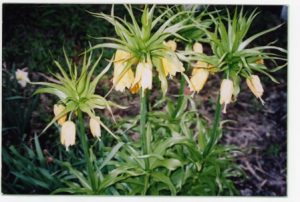Q. My elephant grass just keeps getting smaller year after year. It just dies and kind of turns to dust in the middle. How do I keep from losing them entirely? I would love for them to be lively and beautiful and big. Can you help me please? (Submitted from Charlestown, Ind.)
A. It is quite common for perennial grasses (and other perennials) to die out in the center, particularly those that form dense clumps. The new growth logically occurs to the outer perimeter of the clump while the center gets choked out. Think about it. Allowing a single plant to spread out considerably over the years is an ingenious method of self-propagation. Dividing the clumps every three years or so will help keep the planting more attractive. Be sure to sharpen your garden spade before attempting to divide!
Q. It would be grand to learn what this plant is. (Submitted from Kewanna, Ind.)
A. That is Fritillaria imperialis, commonly known as crown imperial. This spring-flowering bulb reaches 2-3 feet tall and blooms in yellow, orange or red. Crown imperial thrives in deep, moist soil and performs well in full sun or light shade. The bulbs are widely available from local garden centers and mail-order bulb suppliers for fall planting.
